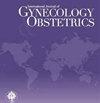Enhancing the accuracy of preoperative and intraoperative evaluation of malignant ovarian germ cell tumors with a focus on fertility preservation in young women
Abstract
Objective
To analyze and improve the accuracy of preoperative assessment and intraoperative frozen-section analysis (FSA) for malignant ovarian germ cell tumors (MOGCTs), especially in the context of fertility preservation.
Methods
A retrospective review of 48 women aged under 40 years, diagnosed with MOGCTs, and treated at Chonnam National University Hospital between July and December 2022 was conducted. The results of preoperative magnetic resonance imaging (MRI), measurement of serum tumor markers (α-fetoprotein [AFP], β-human chorionic gonadotropin, lactate dehydrogenase [LDH], cancer antigen [CA] 125, CA 19–9, CA 72–4, carcinoembryonic antigen), and intraoperative FSA were compared with the final pathology diagnosis.
Results
MRI demonstrated a sensitivity of 95.5%, whereas FSA showed a sensitivity of 72.9% for all MOGCTs. Sensitivities varied according to the subtype, but were consistently higher in MRI (100% for dysgerminoma, 88.9% for immature teratoma, 100% for endodermal sinus tumor, 100% for others). However, there were differences in FSA according to subtype (100% for dysgerminoma, 50.0% for immature teratoma, 100% for endodermal sinus tumor, 25.0% for others). Serum tumor markers also provided diagnostic insights, particularly LDH for dysgerminoma (82.4%) and AFP for immature teratoma (75.0%) and endodermal sinus tumor (100%).
Conclusion
Preoperative MRI and serum tumor marker measurement may be effective in guiding fertility-sparing surgical decisions. MRI could outperform FSA in terms of accuracy, especially for immature teratoma.

 求助内容:
求助内容: 应助结果提醒方式:
应助结果提醒方式:


